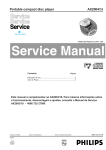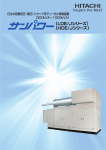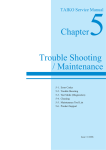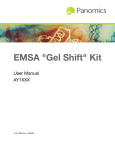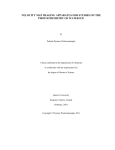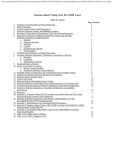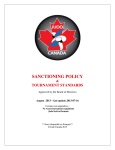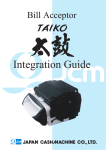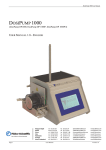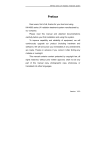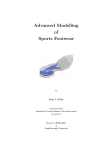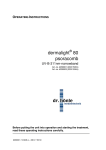Download For Reference Purpose Only!
Transcript
On Cell-Based ELISA Kit for Measuring cyclobutane pyrimidine dimers in situ ly ! Cellular UV DNA-Damage Detection Kit User’s Manual For Research Use Only, Not for use in diagnostic procedures CycLex Cellular UV DNA-Damage Detection Kit Cat# CY-1141 en ce Pu rp Intended Use................................................ 1 Storage......................................................... 1 Introduction.................................................. 2 Principle of the Assay.................................. 2-4 Materials Provided....................................... 5 Materials Required but not Provided........... 5 Precautions and Recommendations.............. 6 Detailed Protocol.......................................... 7-10 Troubleshooting........................................... 10 Reagent Stability...........................................10 Example of Test Results.............................. 11-14 References.................................................... 15 Related Products........................................... 15 os e For 200 Assays Intended Use The CycLex Research Product CycLex Cellular UV DNA-Damage Detection Kit is a non-isotopic immunoassay used for the semi-quantitative measurement of CPDs (cyclobutane pyrimidine dimers) in genomic DNA formed by UV-irradiation to cells. er Applications for this kit include: 1) Detection and semi-quantification of cyclobutane pyrimidine dimers in cells. 2) Monitoring the effects of UV on formation of cyclobutane pyrimidine dimers in cells. 3) Monitoring the effects of UV protection reagent on formation of cyclobutane pyrimidine dimers in cells. 4) Study on the repair mechanisms of UV-induced DNA damage by the nucleotide excision repair in cells. ef This assay kit is for research use only and not for use in diagnostic or therapeutic procedures. Storage rR • Upon receipt store all components at 4°C. • Don’t expose reagents to excessive light. Fo Cat#: CY-1141 1 Version#: 120420 15A Constitution Way · Woburn, MA 01801 · Phone: 1.800.200.5459 · Fax: 781-939-6963 · mblintl.com On Introduction ly ! Cellular UV DNA-Damage Detection Kit User’s Manual For Research Use Only, Not for use in diagnostic procedures rp os e DNA damage in cells exposed to ultraviolet (UV) radiation plays significant roles in cell-cycle arrest, activation of DNA repair, cell killing, mutation, and neoplastic transformation. The major types of DNA damage induced by UVB (280-315 nm, component of sunlight) and by UVC (200-280 nm) are cyclobutane pyrimidine dimers (CPDs) and (6-4) photoproducts (6-4PPs), which are formed between adjacent pyrimidine nucleotides on the same strand of DNA. Approximately 70-80% of UV-induced DNA damage is CPDs and the remaining is 6-4PPs and Dewar isomer of 6-4PPs. These types of DNA lesions are repaired by nucleotide excision repair (NER) system in normal human cells. Mori et al (10) have established monoclonal antibodies specific for CPDs or 6-4PPs. These antibodies enable one to quantitate photoproducts in DNA purified from cultured cells or from the skin epidermis using an enzyme-linked immunosorbent assay (ELISA) and to visualize and measure photoproducts in DNA in cultured cells or the skin using indirect immunofluorescence (IIF). This technology would contribute to understanding of molecular mechanisms of cellular responses to UV and DNA damage in the photobiology and the pigment cell biology. en ce Pu A rapid and convenient method for evaluating the formation of cyclobutane pyrimidine dimers (CPDs) in a cell after UV-irradiation was developed which detects CPDs adducts on the genomic DNA by means of anti-CPDs antibody in a cellular ELISA format. It has been shown that a precise evaluation of CPDs formation, could be performed by the measurement of CPDs adducts in purified genomic DNA by ELISA. In addition, there is a good reverse proportion between the cellular CPDs ELISA value and ability of nucleotide excision repair (NER) when the cell are incubate for several hours after UV-irradiation for repair as shown for a variety of NER deficient cell lines, such as xeroderma patient-derived cell lines. The CycLex Cellular UV DNA-Damage Detection Kit can be used in many different in vitro cell systems without any purification step of genomic DNA. Principle of the Assay rR ef er The CycLex Cellular UV DNA-Damage Detection Kit based on the formation of CPDs on the genomic DNA after UV-irradiation in the cells that are cultured in microtiter plates. After formation of CPDs on DNA, CPDs in the cell is detected by anti-CPDs antibody. During UV-irradiation is carried out on wells of the microtiter plate, CPDs will be formed on the DNA of living cells. To enable antibody binding to the CPDs on the genomic DNA, cells must be fixed, permeabilized and the DNA denatured. Detector anti-CPDs antibody is pipetted into the wells and allowed to incubate for one hour, during which time it binds to any CPDs. Unbound antibody is washed away and horseradish peroxidase-conjugated secondary antibody is added, which binds to the detector antibody. The horseradish peroxidase catalyzes the conversion of the chromogenic substrate tetra-methylbenzidine (TMB) from a colorless solution to a blue solution (or yellow after the addition of stopping reagent). The color is quantified by spectrophotometry and reflects the relative amount of CPDs in the cells. Fo Cat#: CY-1141 2 Version#: 120420 15A Constitution Way · Woburn, MA 01801 · Phone: 1.800.200.5459 · Fax: 781-939-6963 · mblintl.com ly ! Cellular UV DNA-Damage Detection Kit User’s Manual For Research Use Only, Not for use in diagnostic procedures I. Summary of Procedure for adherent cells Culture adherent cells in microplate at 1-4 x 104 cells/well. On The CycLex Cellular UV DNA-Damage Detection Kit is designed to measure the relative levels of cyclobutane pyrimidine dimers on genomic DNA in situ. The summary of the assay is shown in below. os e Incubate O/N at 37°C in CO2 incubator UV-irradiate the cells. Incubate an appropriate time at 37°C in CO2 incubator Discard the culture medium. rp Add 200 µL of Fixing/Denaturing solution. Stand for 30 min at room temp. Pu Discard the Fixing/Denaturing solution. Add 200 µL of Blocking Solution. Incubate 30 min at room temp. en ce Discard the Blocking Solution Add 50 µL of Primary Antibody (Anti-CPDs antibody) Incubate 1 hr at room temp. Wash the wells Add 50 µL of HRP conjugated Secondary Antibody Incubate 1 hr at room temp. Wash the wells er Add 50 µL of Substrate Reagent ef Add 50 µL of Stop Solution rR Measure absorbance at 450 nm Fo Cat#: CY-1141 3 Version#: 120420 15A Constitution Way · Woburn, MA 01801 · Phone: 1.800.200.5459 · Fax: 781-939-6963 · mblintl.com On II. Summary of Procedure for suspension cells ly ! Cellular UV DNA-Damage Detection Kit User’s Manual For Research Use Only, Not for use in diagnostic procedures Culture suspension cells in microplate at 1-2 x 104 cells/well. Incubate O/N at 37°C in CO2 incubator os e UV-irradiate the cells. Incubate an appropriate time at 37°C in CO2 incubator c.f.g. the microplate at 3,500 rpm for 10 min. rp Discard the culture medium Air dry the cells by hair-dryer for 15 min Pu Add 200 µL of Fixing/Denaturing Solution. Stand for 30 min at room temp. Discard the Fixing/Denaturing Solution en ce Add 200 µL of Blocking Solution. Incubate 30 min at room temp. Discard the Blocking Solution Add 50 µL of Primary Antibody (Anti-CPDs antibody) Incubate 1 hr at room temp. Wash the wells er Add 50 µL of HRP conjugated Secondary Antibody Incubate 1 hr at room temp. Wash the wells ef Add 50 µL of Substrate Reagent rR Add 50 µL of Stop Solution Fo Cat#: CY-1141 Measure absorbance at 450 nm 4 Version#: 120420 15A Constitution Way · Woburn, MA 01801 · Phone: 1.800.200.5459 · Fax: 781-939-6963 · mblintl.com On Materials Provided ly ! Cellular UV DNA-Damage Detection Kit User’s Manual For Research Use Only, Not for use in diagnostic procedures All compounds treatment should be assayed in duplicate. The following components are supplied and are sufficient for 200 assays. os e Fixing/Denaturing Solution: One bottle containing 50 mL of Fixing/Denaturing Solution. Ready to use. The solution is a strong alkaline. Wear disposable gloves and eye protection when handling. Blocking Solution: One bottle containing 50 mL of Blocking Solution. Ready to use. 10X Wash Buffer: One bottle containing 100 mL of 10X Wash Buffer containing 2%Tween®-20. 20X Primary Antibody Solution: One vial containing 600 µL of anti-cyclobutane pyrimidine dimers antibody. rp Primary Antibody Dilution Buffer: One bottle containing 12 mL of Primary Antibody Dilution Buffer. Ready to use. Pu 20X Secondary Antibody Solution: One vial containing 600 µL of HRP (horseradish peroxidase) conjugated Secondary Antibody. Secondary Antibody Dilution Buffer: One bottle containing 12 mL of Secondary Antibody Dilution Buffer. Ready to use. en ce Substrate Reagent: One bottle containing 20 mL of the chromogenic substrate, tetra-methylbenzidine (TMB). Ready to use. Stop Solution: One bottle containing 20 mL of 1 N H2SO4. Ready to use. Sulfuric Acid is a strong acid. Wear disposable gloves and eye protection when handling. Materials Required but not Provided rR ef er • 96-well microplate (tissue culture grade, flat bottom) • UV crosslinker or irradiator: Stratalinker 1800 (Stratagene) etc. • Centrifuge with rotor for microplate (for suspension cell only). • Cell culture media • 1X PBS pH 7.2 • Pipettors: 2-20 µL, 20-200 µL and 200-1000 µL precision pipettors with disposable tips. • Precision repeating pipettor • Orbital microplate shaker • Microcentrifuge and tubes for sample preparation. • Vortex mixer • Microplate washer: optional (Manual washing is possible but not preferable) • Software package facilitating data generation and analysis :optional • Reagent reservoirs • Deionized water of the highest quality • Absorbent paper: disposable paper towels • Plate reader capable of measuring absorbance in 96-well plates at dual wavelengths of 450 nm/540 nm. Dual wavelengths of 450/550 or 450/595 nm can also be used. The plate can also be read at a single wavelength of 450 nm, which will give a somewhat higher reading. Fo Cat#: CY-1141 5 Version#: 120420 15A Constitution Way · Woburn, MA 01801 · Phone: 1.800.200.5459 · Fax: 781-939-6963 · mblintl.com On Precautions and Recommendations ly ! Cellular UV DNA-Damage Detection Kit User’s Manual For Research Use Only, Not for use in diagnostic procedures Safety Warnings and Precautions: The CycLex Cellular UV DNA-Damage Detection Kit is designed for research use only and not recommended for internal use in humans or animals. All chemicals should be considered potentially hazardous and principles of good laboratory practice should be followed. os e Technical Notes Pu rp 1. When performing washes manually, avoid introducing bubbles when dispensing liquids into the wells, and ensure each well is filled with buffer, but not overflowing to avoid cross-contamination between wells. Empty wells with a wrist flick motion over an appropriate receptacle, and while still inverted, blot any remaining moisture onto clean absorbent paper. 2. Agitation of wells during incubation of Blocking Buffer and Antibody steps is recommended to reduce non-specific background. If microtiter plate agitator is not available, a platform vortex at a low setting can be used (e.g. level 1 of Fisher’s Genie II platform vortex). If background problems occur, simply increase the number and/or duration of washes. 3. A brief 1X PBS rinse is recommended prior to the addition of the HRP substrate to remove any traces of the Tween®-20 with can interfere with the HRP activity. 4. Do not allow the wells to dry out during the protocol. 5. Incubation temperatures for Primary Antibody and Detection Antibody can be varied and should be empirically determined. General Notes • Allow all the components to come to room temperature before use. en ce • Do not use kit components beyond the indicated kit expiration date. • Rinse all detergent residue from glassware. • Use deionized water of the highest quality. • Do not mix reagents from different kits. er • The buffers and reagents used in this kit contain NaN3 as preservatives. Care should be taken to avoid direct contact with these reagents. • Dispose of tetra-methylbenzidine (TMB) containing solutions in compliance with local regulations. ef • Avoid contact with the alkaline Fixing/Denaturing Solution, the acidic Stop Solution and Substrate Solution which contains hydrogen peroxide. rR • Wear gloves and eye protection when handling immunodiagnostic materials and samples of human origin, and these reagents. In case of contact with the Stop Solution and the Substrate Solution, wash skin thoroughly with water and seek medical attention, when necessary. • CAUTION: Sulfuric Acid is a strong acid. Fixing/Denaturing Solution is a strong alkaline. Wear disposable gloves and eye protection when handling Fixing/Denaturing Solution and Stop Solution. Fo Cat#: CY-1141 6 Version#: 120420 15A Constitution Way · Woburn, MA 01801 · Phone: 1.800.200.5459 · Fax: 781-939-6963 · mblintl.com On Detailed Protocol ly ! Cellular UV DNA-Damage Detection Kit User’s Manual For Research Use Only, Not for use in diagnostic procedures os e The CycLex Cellular UV DNA-Damage Detection Kit includes all reagents except cell culture microplate, for detection of CPDs formed in genomic DNA in cultured cells. Since experimental conditions may vary, treatment cells with test compound should be assayed in duplicate. Disposable pipette tips and reagent troughs should be used for all liquid transfers to avoid cross-contamination of reagents or samples. Preparation of Reagents All reagents need to be brought to room temperature prior to the assay. Assay reagents are supplied ready-to-use, with the exception of 10X Wash Buffer, 20X Primary Antibody Solution and 20X Secondary Antibody Solution. rp 1. Prepare a working solution of Wash Buffer by adding 100 mL of the 10X Wash Buffer (provided) to 900 mL of deionized (distilled) water. Mix well. Store at 4°C for two weeks or -20°C for long-term storage. Pu 2. Prepare a working solution of Primary Antibody Solution: Dilute 20X Primary Antibody Solution 1:20 with Primary Antibody Dilution Buffer. Primary Antibody Solution can be stored for up to one week protected from light at 4°C. Prepare appropriate volume for your assay. You will need 50-60 µL of Primary Antibody Solution per assay well. Discard any unused Primary Antibody Solution after diluted. en ce 3. Prepare a working solution of Secondary Antibody Solution: Dilute 20X Secondary Antibody Solution 1:20 with Secondary Antibody Dilution Buffer. Secondary Antibody Solution can be stored for up to one week protected from light at 4°C. rR ef er Prepare appropriate volume for your assay. You will need 50-60 µL of Secondary Antibody Solution per assay well. Discard any unused Secondary Antibody Solution after diluted. Fo Cat#: CY-1141 7 Version#: 120420 15A Constitution Way · Woburn, MA 01801 · Phone: 1.800.200.5459 · Fax: 781-939-6963 · mblintl.com On Assay Procedure ly ! Cellular UV DNA-Damage Detection Kit User’s Manual For Research Use Only, Not for use in diagnostic procedures A. Culture cells in 96-well microplate and UV irradiation 1. Plate adherent cells into a 96-well microplate at 1-4 x 104 cells/well* in a final volume of 100 µL/well. 2. Incubate the microplate at 37°C over night in CO2 incubator. 3. Remove the culture media. Add 50 µL of sterile PBS in well. os e * For most experiments, 2.5 x 104 cells/well are sufficient and adequate for most adherent cells. 1-2 x 104 cells/well are sufficient and adequate for most suspension cells (See Fig. 1-4). rp 4. Perform UV irradiation** to each well. No irradiation control should be run in duplicate as a negative control. ** 0, 0.1, 0.2, 0.5, 1, 5, 10, 40 J/m2. Pu 5. Remove the PBS. Add 100 µL of the culture medium in well. 6. Incubate the microplate at 37°C for appropriate time in CO2 incubator (in case of repair experiment). en ce Note: Although we suggest to conduct experiments as outlined above, the optimal experimental conditions will vary depending on the parameters being investigated, and must be determined by the individual user. Especially, an appropriate cell number must be optimized for your experiment B. Fixing and denaturing the cells to 96-well plate Fixing and denaturing the cells in the 96-well plates should be done as soon as the desired incubation has completed. er For adherent cells: 1. Remove media from wells with a wrist flick. Avoid touching the bottom of the well and removing cells. ef For suspension cells: 1’. Remove media from wells by centrifugation the 96 well microplate at 2,100 x g for 10 min and then suction using a canulla. Avoid touching the bottom of the well and removing cells. Dry the cells using a hair-dryer for about 15 minutes. After this step, the dried cells can be stored for up to one week at 4°C. rR 2. Add 200 µL/well of Fixing/Denaturing Solution slowly to insure cells are not detached from the plastic. Let stand for 30 minutes at room temperature (ca.25°C). 3. Remove Fixing/Denaturing Solution from wells with a wrist flick. While still inverted, tap the plate gently onto absorbent paper to remove any excess fixing agent still within the wells. Fo Cat#: CY-1141 8 Version#: 120420 15A Constitution Way · Woburn, MA 01801 · Phone: 1.800.200.5459 · Fax: 781-939-6963 · mblintl.com ly ! Cellular UV DNA-Damage Detection Kit User’s Manual For Research Use Only, Not for use in diagnostic procedures On C. Detection of Signals (Addition of Primary and Secondary Antibodies and Substrate Reagent) 1. Add 200 µL/well of Blocking Solution and incubate for at least 30 minutes at room temperature (ca.25°C). 2. Remove Blocking Solution with a wrist flick. os e 3. Add 50 µL/well of Primary Antibody Solution and incubate for 1 hour at room temperature (ca.25°C). Alternatively, this incubation period can be varied between 30–120 minutes, depending on individual requirements. 4. Remove Primary Antibody Solution with a wrist flick. rp 5. Rinse the wells once with 200µl/well of Wash Buffer. 6. Remove Wash Buffer with a wrist flick. While still inverted, tap the plate onto absorbent paper. Pu 7. Wash wells 4 times with 200 µL/well of Wash Buffer for 2 minutes each with shaking at ca. 200 rpm on an orbital microplate shaker. Remove Wash Buffer in-between each wash with a wrist flick. 8. Add 50 µL/well of Secondary Antibody Solution and incubate for 1 hour at room temperature (ca.25°C). en ce 9. Remove Secondary Antibody Solution with a wrist flick. 10. Rinse wells once with 200 µL/well of Wash Buffer. 11. Remove Wash Buffer with wrist flick and tap plate onto absorbent paper. 12. Wash wells 4 times with 200 µL/well of Wash Buffer for 2 minutes each with shaking at ca. 200 rpm on an orbital microplate shaker. Remove Wash Buffer in-between each wash with a wrist flick. 13. After last wash with Wash Buffer, rinse wells once with 300 µl/well of 1X PBS. Remove with a wrist flick and tap onto absorbent paper. Ensure that that no liquid remains in the well. er 14. Add 50 µL/well of Substrate Reagent. (Avoid exposing the microplate to direct sunlight covering the plate with e.g. aluminum foil is recommended). Return Substrate Reagent to 4°C immediately after the necessary volume is removed. ef 15. Incubate the plate for 15-25 minutes at room temperature (ca.25°C). (The incubation time may be extended up to 30 minutes if the reaction temperature is below than 20°C). rR 16. Add 50 µL of Stop Solution to each well in the same order as the previously added Substrate Reagent. 17. Measure absorbance in each well using a spectrophotometric microplate reader at dual wavelengths of 450/540 nm. Dual wavelengths of 450/550 or 450/595 nm can also be used. Read the microplate at 450 nm if only a single wavelength can be used. Wells must be read within 30 minutes of adding the Stop Solution*. Fo Cat#: CY-1141 9 Version#: 120420 15A Constitution Way · Woburn, MA 01801 · Phone: 1.800.200.5459 · Fax: 781-939-6963 · mblintl.com ly ! On Cellular UV DNA-Damage Detection Kit User’s Manual For Research Use Only, Not for use in diagnostic procedures Note-1: Complete removal of liquid at each step is essential to good performance. After the last wash, remove any remaining Wash Buffer by aspirating or decanting. Invert the plate and blot it against clean paper towels. os e Note-2: Although we suggest to conduct experiments as outlined above, the optimal experimental conditions will vary depending on the parameters being investigated, and must be determined by the individual user. Especially, an appropriate cell number must be optimized for your experiment Troubleshooting rp 1. The signals and backgrounds are influenced a great deal by cell line and cell number that you plated, please ensure the appropriate cell number for your experiment. Please conduct the experiment to optimize cell number for this assay. See “Example of Test Results Fig.2 and Fig.4”. Pu 2. Unavoidable background (no UV irradiation) is observed even if an appropriate cells number is used. It is usually around 0.3-0.4 See “Example of Test Results Fig.1 and 3”. 3. With some cell lines, higher cell concentrations (more than 1 × 104 cells/well in case of adherent cells) may lead to increasing absorbance values in no UV irradiation (background) rather than those in UV irradiation. en ce 4. All UV irradiation including no UV irradiation control should be run in duplicate, using the protocol described in the Detailed Protocol. Incubation times or temperatures significantly different from those specified may give erroneous results. 5. Poor duplicates, accompanied by elevated values for wells containing no UV irradiation control, indicate insufficient washing or vigorous washing. Wash the plate thoroughly and gently. 6. Overall low signal may indicate that desiccation of the plate has occurred between the final wash and addition of Substrate Reagent. Do not allow the plate to dry out. Add Substrate Reagent immediately after wash. er Reagent Stability ef All of the reagents included in the CycLex Cellular UV DNA-Damage Detection Kit have been tested for stability. Reagents should not be used beyond the stated expiration date. Upon receipt, kit reagents should be stored at 4°C. For long-term storage of 20X Primary Antibody Solution and 20X Secondary Antibody Solution, it is recommended to store at below -70°C. rR For research use only, not for use in diagnostic or therapeutic procedures Fo Cat#: CY-1141 10 Version#: 120420 15A Constitution Way · Woburn, MA 01801 · Phone: 1.800.200.5459 · Fax: 781-939-6963 · mblintl.com On Example of Test Results Fig.1 UV dose dependency using HeLa cells CPDs 12,500 cells/well HeLa CPDs 25,000 cells/well HeLa 1.2 1.2 os e 1.0 1.0 0.8 A450 0.8 A450 ly ! Cellular UV DNA-Damage Detection Kit User’s Manual For Research Use Only, Not for use in diagnostic procedures 0.6 0.6 0.4 rp 0.4 0.2 0.2 0.0 1 10 J/m2 Pu 0.0 0 100 0 1 J/m2 10 100 CPDs 50,000 cells/well HeLa en ce 1.2 1.0 A450 0.8 0.6 er 0.4 0.2 rR ef 0.0 Fo Cat#: CY-1141 0 1 J/m2 11 10 100 Version#: 120420 15A Constitution Way · Woburn, MA 01801 · Phone: 1.800.200.5459 · Fax: 781-939-6963 · mblintl.com On Fig.2 Effect of cell number on ELISA value using HeLa cells CPDs HeLa 1.2 ly ! Cellular UV DNA-Damage Detection Kit User’s Manual For Research Use Only, Not for use in diagnostic procedures UV 0 UV 0.156J/m2 os e 1.0 UV 0.625J/m2 UV 2.5J/m2 UV 10J/m2 0.6 rp A450 0.8 0.2 0.0 12,500 25,000 Cell number 50,000 rR ef er en ce 0 Pu 0.4 UV 40J/m2 Fo Cat#: CY-1141 12 Version#: 120420 15A Constitution Way · Woburn, MA 01801 · Phone: 1.800.200.5459 · Fax: 781-939-6963 · mblintl.com On Fig.3 UV dose dependency using Raji cells CPDs 12,500 cells/well Raji 1.4 1.2 1.2 1.0 1.0 0.8 0.8 0.6 0.6 0.4 rp 0.4 os e CPDs 25,000 cells/well Raji 1.4 A450 A450 ly ! Cellular UV DNA-Damage Detection Kit User’s Manual For Research Use Only, Not for use in diagnostic procedures 0.2 0.2 0.0 0.0 1 J/m2 10 100 0 1 Pu 0 J/m2 10 CPDs 50,000 cells/well Raji en ce 1.4 1.2 A450 1.0 0.8 0.6 er 0.4 0.2 rR ef 0.0 Fo Cat#: CY-1141 0 1 J/m2 13 10 100 Version#: 120420 15A Constitution Way · Woburn, MA 01801 · Phone: 1.800.200.5459 · Fax: 781-939-6963 · mblintl.com 100 On Fig.4 Effect of cell number on ELISA value using Raji cells ly ! Cellular UV DNA-Damage Detection Kit User’s Manual For Research Use Only, Not for use in diagnostic procedures CPDs Raji UV 0 1.4 os e UV 0.156J/m2 1.2 UV 0.625J/m2 UV 2.5J/m2 1.0 UV 40J/m2 0.6 rp A450 UV 10J/m2 0.8 0.2 0.0 12,500 25,000 Cell number 50,000 rR ef er en ce 0 Pu 0.4 Fo Cat#: CY-1141 14 Version#: 120420 15A Constitution Way · Woburn, MA 01801 · Phone: 1.800.200.5459 · Fax: 781-939-6963 · mblintl.com rp Related Products os e 1. Nishiwaki, Y., et al., J. Invest. Dermatol. 122, 526-532 (2004) 2. Imoto, K., et al., J. Invest. Dermatol. 119, 1177-7782 (2002) 3. Kobayashi, N., et al., Pigment Cell Res. 14, 94-102 (2001) 4. Katsumi, S., et al., J. Invest. Dermatol. 117, 1156-1161 (2001) 5. Otoshi, E., et al., Cancer Res. 60, 1729-1735 (2000) 6. Nakagawa, A., et al., J. Invest. Dermatol. 110, 143-148 (1998) 7. Kobayashi, N., et al., J. Invest. Dermatol. 110, 806-810 (1998) 8. Komatsu, Y., et al., Nucleic Acids Res. 25, 3889-3894 (1997) 9. Kobayashi, N., et al., J. Invest. Dermatol. 101, 685-689 (1993) 10. Mori, T., et al., Photochem. Photobiol. 54, 225-232 (1991) On References ly ! Cellular UV DNA-Damage Detection Kit User’s Manual For Research Use Only, Not for use in diagnostic procedures en ce Pu * CycLex Cellular Histone Acetylation Assay Kit: Cat# CY-1140 * CycLex Cellular UV DNA-Damage Detection Kit: Cat# CY-1141 * CycLex BrdU Cellular ELISA Kit: Cat# CY-1142 * CycLex Histone H2A.X Phosphorylation Cellular ELISA Kit: Cat# CY-1143 PRODUCED BY er CycLex Co., Ltd. 1063-103 Terasawaoka Ina, Nagano 396-0002 Japan Fax: +81-265-76-7618 e-mail: [email protected] URL: http://www.cyclex.co.jp rR ef CycLex/CircuLex products are supplied for research use only. CycLex/CircuLex products and components thereof may not be resold, modified for resale, or used to manufacture commercial products without prior written approval from CycLex Co., Ltd.. To inquire about licensing for such commercial use, please contact us via email. Fo Cat#: CY-1141 15 Version#: 120420 15A Constitution Way · Woburn, MA 01801 · Phone: 1.800.200.5459 · Fax: 781-939-6963 · mblintl.com















